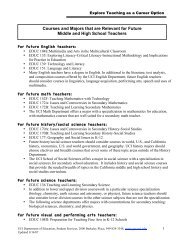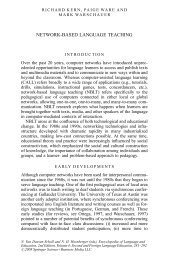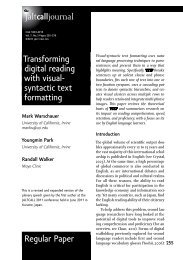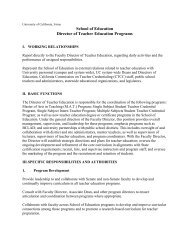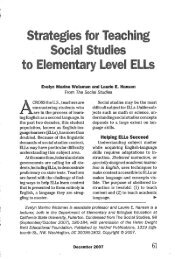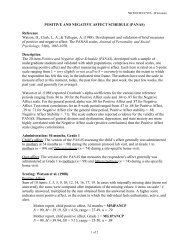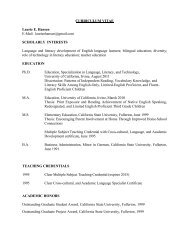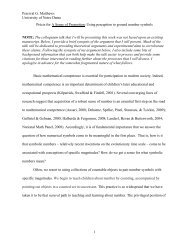Infrastructures for Low-cost Laptop Use in Mexican Schools
Infrastructures for Low-cost Laptop Use in Mexican Schools
Infrastructures for Low-cost Laptop Use in Mexican Schools
You also want an ePaper? Increase the reach of your titles
YUMPU automatically turns print PDFs into web optimized ePapers that Google loves.
<strong>Infrastructures</strong> <strong>for</strong> <strong>Low</strong>-<strong>cost</strong> <strong>Laptop</strong> <strong>Use</strong> <strong>in</strong> <strong>Mexican</strong><strong>Schools</strong>Ruy Cervantes 1 , Mark Warschauer 2 , Bonnie Nardi 1 and Nithya Sambasivan 1Department of In<strong>for</strong>matics 1Department of Education 2University of Cali<strong>for</strong>nia, Irv<strong>in</strong>eUniversity of Cali<strong>for</strong>nia, Irv<strong>in</strong>e{ruy,nardi, nsambasi}@ics.uci.edumarkw@uci.eduABSTRACTIn recent years, a number of low-<strong>cost</strong> laptops have beencreated <strong>for</strong> children’s education, most notably the XO,developed by One <strong>Laptop</strong> per Child to embody pr<strong>in</strong>ciplesof constructionist learn<strong>in</strong>g, and the ClassmatePC, designedby Intel to fit with<strong>in</strong> and improve traditional education. Wereport on a series of field studies <strong>in</strong> <strong>Mexican</strong> elementaryschools that deployed the XO or ClassmatePC. Althoughboth devices are promoted as valuable <strong>for</strong> improv<strong>in</strong>geducation <strong>in</strong> develop<strong>in</strong>g countries, our studies suggest thatcreat<strong>in</strong>g the social and technical <strong>in</strong>frastructures needed tosusta<strong>in</strong> school laptop use is far more complex than whattechnology designers assume.Author Keywords<strong>Low</strong>-<strong>cost</strong> laptops, <strong>in</strong>frastructures, develop<strong>in</strong>g countries,OLPC, XO, ClassmatePC, education, Mexico, ICT4DACM Classification KeywordsK.3.1. Computer uses <strong>in</strong> education: collaborative learn<strong>in</strong>g,computer-assisted <strong>in</strong>struction. K.4.2. Computers andsociety: social issues. H.5.m. In<strong>for</strong>mation <strong>in</strong>terfaces andpresentation (e.g., HCI): Miscellaneous.General TermsHuman factors.INTRODUCTIONIn the last five years, there has been a strong push to createlow-<strong>cost</strong> laptops <strong>for</strong> children <strong>in</strong> develop<strong>in</strong>g countries. Theseef<strong>for</strong>ts—from the computer <strong>in</strong>dustry, non-governmentalorganizations, and governments—were triggered by theOne <strong>Laptop</strong> per Child (OLPC) project [15], which sought tocreate radical educational change by massively distribut<strong>in</strong>gits XO laptop to develop<strong>in</strong>g countries. Envisioned as aresponse to the problems of educational systems <strong>in</strong> thedevelop<strong>in</strong>g world, <strong>in</strong>clud<strong>in</strong>g shortage of teachers and lackof material resources, the XO laptop purportedly embodiedthe pr<strong>in</strong>ciples of constructionist pedagogy to empowerstudents to learn on their own, without support fromPermission to make digital or hard copies of all or part of this work <strong>for</strong>personal or classroom use is granted without fee provided that copies arenot made or distributed <strong>for</strong> profit or commercial advantage and that copiesbear this notice and the full citation on the first page. To copy otherwise,or republish, to post on servers or to redistribute to lists, requires priorspecific permission and/or a fee.CHI 2011, May 7–12, 2011, Vancouver, BC, Canada.Copyright 2011 ACM 978-1-4503-0267-8/11/05....$10.00.teachers [6,7]. Constructionism [25] departs fromtraditional education by emphasiz<strong>in</strong>g students’ constructionof their own artifacts and knowledge. The XO’s mostprom<strong>in</strong>ent competitor is the ClassmatePC, created by Intel.Unlike the XO approach, the ClassmatePC was designed tobe compatible with and <strong>in</strong>tegrated <strong>in</strong>to traditionaleducational systems [33]. Large sales deals recently securedby Intel <strong>in</strong> Brazil and Argent<strong>in</strong>a [1] are signal<strong>in</strong>g a grow<strong>in</strong>gmarket preference <strong>for</strong> the ClassmatePC.To further understand the role of laptops <strong>in</strong> elementaryeducation <strong>in</strong> develop<strong>in</strong>g regions, we conducted case studyresearch on laptop programs <strong>in</strong> a select group of <strong>Mexican</strong>schools. From research conducted <strong>in</strong> developed countries(e.g., [35]), we know that successful school laptopprograms need support<strong>in</strong>g socio-technical <strong>in</strong>frastructures,such as electricity, networks and tech-support<strong>in</strong>frastructures, as well as tra<strong>in</strong>ed teachers, staff, andpedagogical materials. HCI research has started to look ateducational ICTs <strong>in</strong> develop<strong>in</strong>g countries (e.g., [16]), butthe laptop as an educational tool is yet to be <strong>in</strong>vestigated. Abody of research is needed to design educationaltechnologies that can be supported <strong>in</strong> resource-constra<strong>in</strong>edenvironments.The objective of our research was to understand whichresources constituted the socio-technical <strong>in</strong>frastructures thatsupported the use of laptops <strong>in</strong> elementary education <strong>in</strong> adevelop<strong>in</strong>g country, the specific functions of these<strong>in</strong>frastructures, and how these <strong>in</strong>frastructures were created<strong>in</strong> resource-constra<strong>in</strong>ed environments. We found anecology of socio-technical <strong>in</strong>frastructures support<strong>in</strong>g thelaptop programs <strong>in</strong> schools. These <strong>in</strong>frastructures <strong>in</strong>cludedthe laptops; physical <strong>in</strong>frastructures, such as the electricalsystem, build<strong>in</strong>gs, and furniture; and social andorganizational <strong>in</strong>frastructures, such as management,technical support, pedagogical support, and parental<strong>in</strong>volvement. The educational impact of laptops did notsolely depend on the economic resources of the school oron the type of laptops used. Although the socio-economicstatus (SES) of the schools affected their ability to build<strong>in</strong>frastructures, we found that the enthusiasm, commitment,and tra<strong>in</strong><strong>in</strong>g of teachers, staff, parents, and students, alongwith the support of external organizations, helped createsupport <strong>in</strong>frastructures <strong>for</strong> laptops, despite limitedresources. We found that what laptops can achieve depends
heavily on school context, <strong>in</strong>clud<strong>in</strong>g factors such as teacherpreferences, organizational values, and exist<strong>in</strong>g norms.In this paper, we discuss how school communities achieved,or did not achieve, the support <strong>in</strong>frastructures <strong>for</strong> theselaptops. Our study expla<strong>in</strong>s the mundane tasks by whichpeople created complex socio-technical support<strong>in</strong>frastructures when resources were constra<strong>in</strong>ed. F<strong>in</strong>ally,we articulate some of the opportunities <strong>for</strong> ICT designers <strong>in</strong>support<strong>in</strong>g technology-enabled educational change, such asleverag<strong>in</strong>g the assets of school communities implement<strong>in</strong>glaptop programs, empower<strong>in</strong>g the community to create thesupport <strong>in</strong>frastructures <strong>for</strong> laptop usage, and consider<strong>in</strong>gimplementation models other than one-to-one comput<strong>in</strong>g.RELATED WORK AND THEORETICAL MOTIVATIONSSeveral low-<strong>cost</strong> computers aimed <strong>for</strong> the develop<strong>in</strong>g worldhave failed to be adopted, as designers overlooked users’contexts [24]. Analyses of educational ICTs <strong>in</strong> develop<strong>in</strong>gcountries have studied the different actors and entitiesnecessary to create support <strong>in</strong>frastructures [8,24,27,34,35],and how the relationships are negotiated [20]. Theseanalyses are useful <strong>for</strong> aid<strong>in</strong>g policy-mak<strong>in</strong>g but lack thedetail required <strong>for</strong> technology design. Recent work <strong>in</strong> HCIhas started to cover this gap; Kumar et al. [16] identifiededucational opportunities <strong>for</strong> out-of-school mobile learn<strong>in</strong>g<strong>in</strong> India, conclud<strong>in</strong>g that learn<strong>in</strong>g will <strong>in</strong>crease accord<strong>in</strong>g tothe availability of appropriate sociotechnical <strong>in</strong>frastructures.We need accounts of how laptop <strong>in</strong>frastructures areconstituted <strong>in</strong> practice to better understand howrelationships between material resources and communitiescreate these <strong>in</strong>frastructures [32]. <strong>Infrastructures</strong> are broadunderly<strong>in</strong>g frameworks encompass<strong>in</strong>g physical, social, andcultural resources that enable groups, organizations, orsocieties to function <strong>in</strong> certa<strong>in</strong> ways [19]. Given thecentrality of social resources <strong>in</strong> educational activities, wefocus on the role of the social to study laptop<strong>in</strong>frastructures. The question <strong>for</strong> us is not only whatresources make up laptop <strong>in</strong>frastructures, but also whenthose resources make an <strong>in</strong>frastructure [32], i.e., what k<strong>in</strong>dsof <strong>in</strong>teractions between th<strong>in</strong>gs and people help develop an<strong>in</strong>frastructure. Star and Ruhleder found that <strong>in</strong>frastructuresare built on an <strong>in</strong>stalled base of <strong>in</strong>herited strengths andlimitations, reach beyond a s<strong>in</strong>gle event or site, areembedded <strong>in</strong>to other structures and social arrangements, arelearned as part of membership with <strong>in</strong>com<strong>in</strong>g membershav<strong>in</strong>g to learn them, are l<strong>in</strong>ked with conventions ofpractice as they shape and are shaped by communities, aretransparent until they break down, and take time andnegotiation to adjust with other systems with which they are<strong>in</strong>volved [32]. Star and Ruhleder's framework provides uswith specific notions to discuss the complexities of creat<strong>in</strong>glaptop <strong>in</strong>frastructures, allow<strong>in</strong>g us to relate our work to thegrow<strong>in</strong>g body of HCI literature that has looked at the<strong>in</strong>frastructures susta<strong>in</strong><strong>in</strong>g ICTs <strong>in</strong> different contexts.Scholars <strong>in</strong> sociotechnical analysis of comput<strong>in</strong>g<strong>in</strong>frastructures have studied multiple contexts[17,18,14,19,30,32,38], but we are not aware of<strong>in</strong>frastructure studies of education <strong>in</strong> the develop<strong>in</strong>g world.Social accounts of technological <strong>in</strong>frastructures used byprofessionals have documented how the material and socialconditions of develop<strong>in</strong>g countries constra<strong>in</strong> <strong>in</strong>teractions[14,38]. Interactions are shaped by a lack of organizationalresources [17] and accountabilities across multipleorganizational levels [18,30]. We argue that manypreviously identified constra<strong>in</strong>ts are present <strong>in</strong> laptop<strong>in</strong>frastructures of resource-constra<strong>in</strong>ed schools, such asmaterial <strong>in</strong>frastructures that are less robust than <strong>in</strong> high<strong>in</strong>comecountries; concerns of <strong>in</strong>security and theft;underdeveloped staff; and accountabilities at multiple levels<strong>in</strong>clud<strong>in</strong>g to school boards, districts, and state and federalm<strong>in</strong>istries of education. Our study contributes to thesociotechnical analysis literature by show<strong>in</strong>g how creat<strong>in</strong>gsupport <strong>in</strong>frastructures is a matter of deal<strong>in</strong>g with multiplesocio-technical constra<strong>in</strong>ts that <strong>in</strong>teract <strong>in</strong> complex ways.ICT4D and HCI4D literature have <strong>in</strong><strong>for</strong>med our views ofhow <strong>in</strong>frastructures are built <strong>in</strong> constra<strong>in</strong>ed environments.Studies exam<strong>in</strong><strong>in</strong>g large scale ICT projects <strong>for</strong> schoolchildren (e.g., [8,24]) have found them susta<strong>in</strong>able only ifthey address local communities’ current practices [10] or ifthey create opportunities <strong>for</strong> new practices profit<strong>in</strong>g fromexist<strong>in</strong>g sociotechnical <strong>in</strong>frastructures [26]. We are<strong>in</strong><strong>for</strong>med by studies critiqu<strong>in</strong>g the personal-use privateownershipparadigm <strong>in</strong> develop<strong>in</strong>g countries, where, due tosociotechnical constra<strong>in</strong>ts, a shared use model is often moreappropriate [24,31], <strong>in</strong>clud<strong>in</strong>g multiple mice per computer[31]. Ames has studied the country-wide XO deployment <strong>in</strong>Uruguayan elementary schools [6]. Our work differs fromAmes’ project by compar<strong>in</strong>g deployments of two differenttechnological plat<strong>for</strong>ms—Classmate and XO—and bylook<strong>in</strong>g at the <strong>Mexican</strong> educational system, which hasmany more social and organizational deficiencies than theUruguayan educational system. Our study contributes toICT4D and HCI4D by provid<strong>in</strong>g designers with a holisticview of the complexities of creat<strong>in</strong>g laptop <strong>in</strong>frastructures<strong>for</strong> educational change and by show<strong>in</strong>g how communitiescan leverage the ecology of tools, policies, and programs tocreate their self-reliant and susta<strong>in</strong>able <strong>in</strong>frastructures. Wecontribute to HCI4D by study<strong>in</strong>g technology use <strong>in</strong> Mexico,a high mid-<strong>in</strong>come country fac<strong>in</strong>g the challenge of unequaldistribution of socio-economic and pedagogical resources.Our understand<strong>in</strong>g of the human <strong>in</strong>frastructure <strong>in</strong>educational ICT has been <strong>in</strong>fluenced by the educationliterature, which has established teachers and pedagogicalsupport as crucial resources <strong>for</strong> educational ICT projects.Mere access to technology does not automatically enablestudents to use computers to educate themselves, especially<strong>in</strong> low-SES environments, if students lack social support athome or school [8,12,22,34,35]. Teachers are a fundamentalpart of the <strong>in</strong>frastructure to support laptops, provid<strong>in</strong>g the<strong>in</strong>struction, mentor<strong>in</strong>g, and model<strong>in</strong>g required <strong>for</strong> learn<strong>in</strong>g.Teachers are also users of the technical and pedagogical<strong>in</strong>frastructures <strong>in</strong> the classroom. Although ours is not an
education-focused paper, the empirical data presented hereserve the educational community <strong>in</strong> research and policymak<strong>in</strong>gto better understand the challenges that teachers,staff and parents face when creat<strong>in</strong>g laptop support<strong>in</strong>frastructures <strong>in</strong> resource-constra<strong>in</strong>ed environments.BACKGROUNDMexico is a mid-<strong>in</strong>come country with strong socioeconomicdisparities. S<strong>in</strong>ce many who can af<strong>for</strong>d it seekeducation <strong>in</strong> private <strong>in</strong>stitutions [11], the majority of publicschools serve less advantaged students. Programs toupgrade <strong>in</strong>frastructure and <strong>in</strong>troduce ICTs <strong>in</strong> educationhave sought to overcome disparities with mixed results[21]. Curriculum re<strong>for</strong>m aim<strong>in</strong>g to prepare students <strong>for</strong> the21 st century has been difficult to implement due todeficiencies <strong>in</strong> teacher tra<strong>in</strong><strong>in</strong>g [28]. The ―Mochila Digital‖(Digital Backpack), a large-scale project started <strong>in</strong> 2008 bythe private Telmex Foundation, distributed 50,000 XOlaptops <strong>in</strong> about 1,200 <strong>Mexican</strong> elementary public schools<strong>in</strong> cooperation with the M<strong>in</strong>istry of Education [2,3].Participat<strong>in</strong>g schools received 40 XO laptops to be sharedamong all students. On a smaller scale, Intel’s World Aheadprogram ran a series of pilot projects <strong>in</strong> <strong>Mexican</strong>elementary schools beg<strong>in</strong>n<strong>in</strong>g <strong>in</strong> 2007 to test itsClassmatePCs [13], provid<strong>in</strong>g both laptops and substantialadm<strong>in</strong>istrative and tra<strong>in</strong><strong>in</strong>g support [33].STUDY RATIONALEOur case study was designed to understand the sociotechnical<strong>in</strong>frastructures that support a laptop program. Weselected five different schools <strong>in</strong> two <strong>Mexican</strong> cities,segment<strong>in</strong>g them by SES and by type of laptop deployed,namely Classmate and XO. We segmented the schools bySES <strong>in</strong>to two high-SES and three low-SES schools (seeTable 1), which allowed us to contrast how people createdlaptop support <strong>in</strong>frastructures <strong>in</strong> resource-constra<strong>in</strong>edenvironments and <strong>in</strong> high-resource environments.Segment<strong>in</strong>g by type of laptop helped us determ<strong>in</strong>e if thesupport <strong>in</strong>frastructures were different <strong>in</strong> each case, and ifdifferences <strong>in</strong> type of laptop brought changes <strong>in</strong> theireducational function. The schools <strong>in</strong> our sample haddifferent degrees of <strong>in</strong>ternal organizational maturity and ofsupport from parents and external organizations.Contrast<strong>in</strong>g these differences allowed us to understand howorganization and support enable, or not, the creation ofsocio-technical <strong>in</strong>frastructures. Another dimension aga<strong>in</strong>stwhich we compared how <strong>in</strong>frastructures were <strong>for</strong>med wasthe age of the laptop program at each school, vary<strong>in</strong>g froma few months to two school years. The f<strong>in</strong>al criterion <strong>for</strong> thedesign of our study was the use model of the laptopfollowed at each school. The largest XO implementation <strong>in</strong>the world, Plan Ceibal <strong>in</strong> Uruguay [4] follows a one-to-oneuse model. However the largest XO implementation <strong>in</strong>Mexico, Mochila Digital, and other smallerimplementations, follow a shared use model. Peru’snationwide implementation [36], and a smaller program <strong>in</strong>Haiti [23], also have moved towards a shared use model.Given the prevalence of the shared use model <strong>in</strong> Mexico,we selected a majority of sites that followed this practice.METHODSWe conducted 128 hours of observations (see Table 1) toexam<strong>in</strong>e the role of laptops <strong>in</strong> teach<strong>in</strong>g and learn<strong>in</strong>gactivities, the resources needed to conduct these activities,and how teachers and staff prepared <strong>for</strong> these activities. Wedocumented our observations with extensive field notes,photographs of <strong>in</strong>-class <strong>in</strong>teractions of teachers andstudents, and collection of samples of work of students andpedagogical materials. We observed classroom activitiesthat did and did not <strong>in</strong>volve laptops, teacher meet<strong>in</strong>gs,school assemblies, parent meet<strong>in</strong>gs, and social gather<strong>in</strong>gs ofteachers and staff. We also observed laptop supportactivities, such as how laptops were charged, stored, andtransported to the classroom.We conducted 41 semi-structured <strong>in</strong>terviews of 20 to 60m<strong>in</strong>utes with staff, teachers, parents, and students. In these<strong>in</strong>terviews we asked teachers, staff and parents about theirperception of the laptop project, the history anddevelopment of the programs, and the process to implementthe program, and the social, organizational, pedagogical andtechnical resources necessary <strong>for</strong> the program. We askedstudents, teachers, and staff about the educational uses andpractices that <strong>in</strong>volved laptops, and compared theirresponses aga<strong>in</strong>st our observations, to be able to understandto what degree the perceived uses corresponded to observeduse. We digitally recorded, coded, and transcribed allConocerte Del Valle Miguel Hidalgo Independencia Octavio PazLocation Guadalajara Guadalajara Puebla Guadalajara GuadalajaraSES High – Private High – Private <strong>Low</strong> – Public <strong>Low</strong> – Public <strong>Low</strong> – Public<strong>Laptop</strong> Type ClassmatePC-1 ClassmatePC-1 ClassmatePC-1 XO-1 XO-1Program Independent Intel supported pilot Intel/State govt. pilot Mochila Digital Mochila DigitalActive period 2007-2009 2007- date 2007- date 2009-date 2009-date<strong>Laptop</strong> ratio 1-to-1 1st yr., 1-to-1. Then shared. Shared Shared SharedNo. laptops 60 40 50 40 40Observations N/A. Nov/09: 10 days. ~40hrs. Dec/09: 10 days. Dec/09-Mar/10: 6 Dec/09-Mar/10: 6Interviews1 staff member,2 teachers7 students, 1 teacher, 2 staff, 2parents.~40hrs.8 students, 3 teachers,1 staff, 4 parents.days. ~24hrs.5 teachers, 1staff.Table 1: Characteristics of the observed urban elementary schools <strong>in</strong> Mexico.days. ~24hrs.3 teachers,Pr<strong>in</strong>cipal.
<strong>in</strong>terviews, and coded the field notes and pictures. Ourcod<strong>in</strong>g was bottom-up, and the themes reported <strong>in</strong> ourf<strong>in</strong>d<strong>in</strong>gs emerged from the data. The field researcher is<strong>Mexican</strong> and was educated there; all fieldwork wasconducted <strong>in</strong> Spanish. Translations from Spanish are ours.Pseudonyms are used <strong>for</strong> schools and people.THE SITES<strong>Low</strong>-SES schoolsWe had three public, low-SES schools <strong>in</strong> our sample. TheMiguel Hidalgo School ClassmatePC program wassponsored by Intel and the Puebla State M<strong>in</strong>istry ofEducation. Independencia and Octavio Paz schools werepart of the Mochila Digital program and used XO laptops.The Miguel Hidalgo School, a public elementary school <strong>in</strong>the city of Puebla, started its ClassmatePC program with 50laptops <strong>in</strong> October 2007 [13]. The school had ample priorexperience us<strong>in</strong>g ICTs. It has had a computer room s<strong>in</strong>ce1998. The pr<strong>in</strong>cipal was supportive of technology projects,and the school’s technology coord<strong>in</strong>ator was tra<strong>in</strong>ed <strong>in</strong> bothtechnology and ICT pedagogy. Both sponsors gave ampletechnical and pedagogical support to the school, and theirpedagogical support personnel frequently visited the school.The XO schools, Independencia and Octavio Paz, werelocated <strong>in</strong> low-SES neighborhoods of Guadalajara.Independencia was a stable older school with veteranteachers. Parents had a seem<strong>in</strong>gly good relationship withthe school authorities. Octavio Paz School was relativelynew and grow<strong>in</strong>g fast. <strong>Low</strong>er grade classes had close to 50students each, and classroom space was runn<strong>in</strong>g out. Schooladm<strong>in</strong>istrators <strong>in</strong>dicated that parental participation was low,which they attributed to long work<strong>in</strong>g hours of low-<strong>in</strong>comeparents. The XO laptops were delivered to Independenciaand Octavio Paz <strong>in</strong> spr<strong>in</strong>g 2009. Technical tra<strong>in</strong><strong>in</strong>g wasprovided only to two staff or teachers per school, and notuntil October of that year. Those tra<strong>in</strong>ed were expected toreplicate the tra<strong>in</strong><strong>in</strong>g to their peers. The XO schools facednumerous technical problems, as discussed below.High-SES schoolsThe two high-SES schools were located <strong>in</strong> wealthyneighborhoods of Guadalajara. Both were runn<strong>in</strong>gClassmatePC laptop programs. These private schools hadwell-tra<strong>in</strong>ed teachers and a good relationship with parents.Both schools have had well-equipped computer rooms <strong>for</strong>at least 10 years. Most classrooms <strong>in</strong> these schools hadLCD projectors and a computer <strong>for</strong> the teacher. The DelValle school program was also <strong>in</strong>itiated as an Intelsponsored pilot project <strong>in</strong> 2007. Dur<strong>in</strong>g the first year, theschool’s 40 ClassmatePCs were allocated on a one laptopper student basis to all sixth grade students. After the firstyear, laptops were used on a shared basis among gradefour-to-six students. The other private school, Conocerte,<strong>in</strong>dependently acquired ClassmatePCs <strong>in</strong> 2007, toimplement a one-to-one laptop program <strong>in</strong> grades 5 and 6.The program lasted until spr<strong>in</strong>g 2009 (see discussionbelow). Students’ parents covered the <strong>cost</strong> of purchase oflaptops, and laptops were managed by the school’stechnology coord<strong>in</strong>ator. After several months, studentswere allowed to take the laptops home. As Conocerte hadthe longest runn<strong>in</strong>g one-to-one laptop program <strong>in</strong> Mexicothat we were aware of, we decided to <strong>in</strong>clude the school <strong>in</strong>our sample, even though the program was no longer activeat the time of our visit. We <strong>in</strong>terviewed extensively the twoteachers who had used the laptops with their classes and atechnical support staff member.FINDINGSMore than the laptop, it was the support <strong>in</strong>frastructures thatmade an educational difference. In low-SES schools, bothus<strong>in</strong>g XOs and ClassmatePCs, much ef<strong>for</strong>t was expended tobuild <strong>in</strong>frastructures to enable students to access learn<strong>in</strong>genvironments that they had no access to otherwise. <strong>Schools</strong>that solved the access issue—all high-SES schools and onelow-SES—built <strong>in</strong>frastructures to capitalize on students’enthusiasm <strong>for</strong> technology to motivate them to be more<strong>in</strong>dependent learners. <strong>Schools</strong> changed their teach<strong>in</strong>g andlearn<strong>in</strong>g practices, only after their <strong>in</strong>frastructure was solid,and teachers had enough technical and pedagogical supportto change their practices. How laptops were used totrans<strong>for</strong>m educational practices was determ<strong>in</strong>ed by theskills and <strong>in</strong>terests of the teachers, the motivation ofstudents, and the values of the schools, rather than theaf<strong>for</strong>dances of the laptops alone.Learn<strong>in</strong>g environments are laptops plus teachersMost of the low-SES students’ previous experience withtechnology was restricted by either limited physical accessor limited social support. Accord<strong>in</strong>g to teachers, between ahalf and one-third of students <strong>in</strong> the observed schools hadcomputers and Internet access at home. Though cybercaféswere ubiquitous, few low-SES parents felt com<strong>for</strong>tablelett<strong>in</strong>g their elementary school children attend them orcould af<strong>for</strong>d the <strong>cost</strong>s. <strong>Low</strong>-SES students who did f<strong>in</strong>doutside access to computers often lacked mentors. Onlysome students had parents, older sibl<strong>in</strong>gs, or other relativeswith extensive computer experience. Many had to learncomputer skills on their own.<strong>Laptop</strong> programs provided the opportunity to accesseducational resources because students could use laptopswith the guidance of a teacher or technology coord<strong>in</strong>ator <strong>in</strong>an environment conducive <strong>for</strong> learn<strong>in</strong>g. The use of XOs bytwo 3 rd grade groups at Independencia illustrates howlaptops plus teachers made the difference to create aproductive learn<strong>in</strong>g environment. In ―3-A‖, students usedthe XO without teacher supervision, as their teacher was nottra<strong>in</strong>ed to use the XO. When the teacher handed out thelaptops, she told students that they could ―chat.‖ Somestudents started communicat<strong>in</strong>g us<strong>in</strong>g the Chat program, butothers were not able to figure it out, leav<strong>in</strong>g them frustrated.Students of ―3-B‖ conducted an educational activity whichconsisted of play<strong>in</strong>g the popular song ―Brother John‖ us<strong>in</strong>gTamTam, an XO music creation program. Their teacherpr<strong>in</strong>ted the activity handout from the Mochila Digital’ssupport site. Us<strong>in</strong>g the handout and their teacher’sassistance, students could play the song on their own. The
activity of 3-A had little educational value, as manystudents had chatted be<strong>for</strong>e at cybercafés and those whowere not able to chat did not receive guidance to use theprogram. In contrast, the activity of 3-B allowed manystudents to create music on the computer <strong>for</strong> their first time.It is pretty but not practicalMak<strong>in</strong>g the laptops ―practical‖ to use, and easy to <strong>in</strong>tegrate<strong>in</strong>to teach<strong>in</strong>g and learn<strong>in</strong>g practices, was a function of theorganizational capacity of the school, and not necessarilyl<strong>in</strong>ked to its SES. Miguel Hidalgo had a solid <strong>in</strong>ternalorganization, support from parents, and good relations withthe M<strong>in</strong>istry of Education. With the advice of the M<strong>in</strong>istryof Education, the school built a ―charg<strong>in</strong>g center‖ to chargeand store all laptops. Its <strong>cost</strong> of nearly $700 US was paid<strong>for</strong> by parents. In contrast, the electrical <strong>in</strong>frastructure atOctavio Paz was unreliable. The pr<strong>in</strong>cipal bought somepower-strips to charge the laptops at the s<strong>in</strong>gle electricaloutlet of each classroom, mak<strong>in</strong>g laptop charg<strong>in</strong>g labor<strong>in</strong>tensive.This <strong>in</strong>convenience made Octavio Paz’s teacherscharacterize the XO laptops as ―pretty‖ but not ―practical‖.The lack of engagement between Octavio Paz staff and theparents made it impossible to raise funds <strong>for</strong> a reliableelectrical <strong>in</strong>frastructure.In high-SES schools, where provid<strong>in</strong>g laptops and physical<strong>in</strong>frastructures was not a problem, social organization wasstill crucial <strong>for</strong> us<strong>in</strong>g laptops reliably. When the technologycoord<strong>in</strong>ator at Conocerte, a high-SES school, resigned, thelaptop program was officially ended. Still, many parentscont<strong>in</strong>ued to buy netbooks <strong>for</strong> their children, and thesestudents regularly brought their netbooks to school.However, teachers had reservations about us<strong>in</strong>g thenetbooks <strong>in</strong> class, as some students had ―<strong>in</strong>appropriate‖material on their netbooks, such as violent videos, andteachers were also worried about computer viruses.Conocerte teachers told us they had felt much moreconfident <strong>in</strong> the laptops when the technology coord<strong>in</strong>atorused to manage the program and help ensure that themach<strong>in</strong>es were used <strong>for</strong> educational purposes.Elsewhere, lack of local knowledge of its SugarOS madethe XO difficult to ma<strong>in</strong>ta<strong>in</strong>. Between a half and a third ofXO mach<strong>in</strong>es of the Mochila Digital schools were receivedwith a software-lock, as the security layer of SugarOS,called ―BitFrost,‖ had no activation key. Load<strong>in</strong>g the keyson the computers was relatively complex <strong>for</strong> a nontechnicaluser. Also, the laptops were not configured toaccess the Internet. Technical support was provided ma<strong>in</strong>lyover the phone, with no <strong>in</strong>-person support. Technicalsupport of Mochila Digital was slow to respond, andschools could not use local technical expertise s<strong>in</strong>ceSugarOS was virtually unknown.Insecurity and robbery are a reality <strong>in</strong> Mexico, and it was aconcern <strong>in</strong> all schools, directly impact<strong>in</strong>g access tocomput<strong>in</strong>g. At the high-SES Del Valle School, all of thelaptops were stolen from a locked room a few weeks be<strong>for</strong>eour arrival. To carry on with their activities, and also toallow us to per<strong>for</strong>m the study, the school borrowed laptopsused at a sister campus <strong>for</strong> a few weeks. Staff expla<strong>in</strong>ed tous that it would take months to replace the stolen laptops.The robbery made evident the vulnerability of comput<strong>in</strong>g<strong>in</strong>frastructures to the larger social context of a countrywhere even low-<strong>cost</strong> laptops are valuable items.One-to-one is aspired to, but shar<strong>in</strong>g is more practicalOne-to-one laptop programs were practically achievable <strong>in</strong>only one school. Even if a one-to-one laptop program wasan aspiration <strong>for</strong> most teachers and staff, the laptops’ <strong>cost</strong>and lack of requisite socio-technical support made this goal<strong>in</strong>feasible. Only Conocerte, the most privileged school, wasable to susta<strong>in</strong> a one-to-one program <strong>for</strong> a prolonged period.For the technology coord<strong>in</strong>ator of Del Valle, a high-SESschool, a susta<strong>in</strong>able one-to-one program was achievable <strong>in</strong>two years, after lobby<strong>in</strong>g with school authorities, build<strong>in</strong>g aschool network, and work<strong>in</strong>g out f<strong>in</strong>anc<strong>in</strong>g with parents.<strong>Low</strong>-SES schools shared laptops, given the lower capacityof their social and physical <strong>in</strong>frastructures, and theperceived benefit of giv<strong>in</strong>g access to all schools students asopposed to a s<strong>in</strong>gle class with a one-to-one program. At theMiguel Hidalgo School, the pr<strong>in</strong>cipal chose to share their50 ClassmatesPCs laptops among the twelve groups of theschool, over hav<strong>in</strong>g a s<strong>in</strong>gle group <strong>in</strong> a one-to-one program.The pr<strong>in</strong>cipal considered that shar<strong>in</strong>g was better, as allstudents would have a ―chance to open [their] m<strong>in</strong>ds‖ tonew ways of learn<strong>in</strong>g us<strong>in</strong>g the laptops under the guidanceof their teachers. The value of us<strong>in</strong>g laptops was <strong>in</strong><strong>in</strong>creas<strong>in</strong>g the access to technology <strong>for</strong> all students, beyondmak<strong>in</strong>g teach<strong>in</strong>g and learn<strong>in</strong>g more efficient.Shar<strong>in</strong>g laptops entailed practical problems, as neitherlaptop was designed <strong>for</strong> multiple users. First, transport<strong>in</strong>glaptops between classrooms was an issue. <strong>Schools</strong>established weekly schedules to allocate a couple of hoursper group. And mov<strong>in</strong>g laptops from classroom toclassroom required coord<strong>in</strong>ation and time. For <strong>in</strong>stance, atthe Miguel Hidalgo school, each group picked up thelaptops from the media room and took them to theirclassroom (see figure 1). This rout<strong>in</strong>e was time-consum<strong>in</strong>g;it would have been more efficient to set up the laptopspermanently at the media room. But tak<strong>in</strong>g ―the technology<strong>in</strong>side the classroom‖, the technology coord<strong>in</strong>atorexpla<strong>in</strong>ed, was someth<strong>in</strong>g that students ―liked and wereexcited about‖ as it made students feel closer to technology,especially to those with no computer at home. The secondFigure 1: Students transport<strong>in</strong>g the laptops to their classroom.
issue was stor<strong>in</strong>g students’ work. Miguel Hidalgo’s laptopswere labeled so each student would work on the samemach<strong>in</strong>e every time, stor<strong>in</strong>g their work <strong>in</strong> a folder with theirname. In schools us<strong>in</strong>g XOs, students were not able to savetheir work on the laptop, as it had limited memory and theOS had no folders. At the Independencia School, someteachers asked students to buy USB flash drives, but onlyone third of parents were able to buy them. Students sharedtheir drives with others who did not have one, but thepractice was <strong>in</strong>effective and many times the work was lost.Improv<strong>in</strong>g the low-SES schools’ <strong>in</strong>frastructures <strong>for</strong>implement<strong>in</strong>g schoolwide one-to-one laptop programsrequires a holistic approach. Nation-state support isrequired as few parents can pay <strong>for</strong> laptops or requisite<strong>in</strong>frastructure upgrades. Electrical <strong>in</strong>stallations <strong>for</strong> mostclassrooms were <strong>in</strong>ferior. Storage arrangements would haveto be made <strong>in</strong> many overpopulated classrooms, andschoolwide wireless networks would need to be established.Outside of a few schools, more attention to build<strong>in</strong>g thesocial <strong>in</strong>frastructure <strong>in</strong> support of laptop use is required.However, the technology coord<strong>in</strong>ator of Miguel Hidalgofelt that at well-organized low-SES schools such as hers,with ―good teachers and staff,‖ a one-to-one laptop programwould be implemented with positive educational results.Build<strong>in</strong>g the community that builds the <strong>in</strong>frastructureFor low-SES schools, creat<strong>in</strong>g organizations that buildreliable <strong>in</strong>frastructures <strong>in</strong> a context prone to breakdownswas crucial, and required great ef<strong>for</strong>t. Some communitybuild<strong>in</strong>gpractices were mediated by the use of the laptopsthemselves. To <strong>in</strong>crease the <strong>in</strong>volvement of parents atMiguel Hidalgo school, they would be regularly <strong>in</strong>vited toeducational events to use the laptops with their children.We observed an event where parents worked with theirchildren creat<strong>in</strong>g a Word document about the mostimportant values of their family. These k<strong>in</strong>ds of eventsallowed parents—with little experience with computers—toexperience first-hand the power of laptops at school.Involv<strong>in</strong>g and support<strong>in</strong>g teachers was fundamental <strong>for</strong> thecont<strong>in</strong>uity and success of the program. Technologycoord<strong>in</strong>ators and support staff were key to support<strong>in</strong>gteachers’ <strong>in</strong>volvement. Ms. Alejandra, a teacher at MiguelHidalgo School expla<strong>in</strong>ed that ―the teacher‖ was the mostimportant resource <strong>for</strong> a laptop program. Ms. Marian, thetechnology coord<strong>in</strong>ator at Miguel Hidalgo, expla<strong>in</strong>ed thather responsibility was ―to guide the teacher so he or she caneffectively see the laptop as someth<strong>in</strong>g positive‖. For this,Marian had the support of personnel from Intel and theM<strong>in</strong>istry of Education. Marian <strong>in</strong>vited teachers with poorcomputer literacy skills to follow the computer literacylessons imparted to students. Sometimes students wouldhelp teachers <strong>in</strong> their learn<strong>in</strong>g process (see figure 2). Thisstrategy helped to tra<strong>in</strong> teachers and <strong>in</strong>tegrate them to thelaptop program by mak<strong>in</strong>g teachers feel com<strong>for</strong>table astechnology learners, without los<strong>in</strong>g face with their students.This way, Marian was able to ―change the culture of theteachers,‖ to become lifelong learners of technology.Build<strong>in</strong>g a social network of teachers beyond the schoolwas viewed as important. At Independencia, the laptopprogram coord<strong>in</strong>ator expla<strong>in</strong>ed that one of the challenges<strong>for</strong> program cont<strong>in</strong>uity was susta<strong>in</strong><strong>in</strong>g teacher motivation.She believed that enabl<strong>in</strong>g teachers to acquire cont<strong>in</strong>uousICT tra<strong>in</strong><strong>in</strong>g would be the key. As part of the solution, shepictured a network of teachers who could share their uses oftechnology <strong>in</strong> the classroom, creat<strong>in</strong>g a sense of belong<strong>in</strong>gand support. But this network was difficult to br<strong>in</strong>g about,as the Mochila Digital schools were spread out around thecity. Onl<strong>in</strong>e networks could be a solution, but those taketime to build well and had not been developed.Motivat<strong>in</strong>g students with their laptop enthusiasm<strong>Schools</strong> with more stable laptop <strong>in</strong>frastructures, namely DelValle, Conocerte, and Miguel Hidalgo, were able to usestudents’ enthusiasm <strong>for</strong> laptops to motivate them to work<strong>in</strong>dependently. Teachers could capitalize on students’enthusiasm by cont<strong>in</strong>uously creat<strong>in</strong>g activities <strong>in</strong> whichstudents experienced a new way of learn<strong>in</strong>g that was moreenjoyable, more dynamic, and closer to their <strong>in</strong>terests.<strong>Laptop</strong>s became an auxiliary tool to capture students’attention, create support<strong>in</strong>g material <strong>for</strong> difficult subjects,and help students produce higher quality work.Develop<strong>in</strong>g students’ motivation was a blend of laptopaf<strong>for</strong>dances and social practices. Students enjoyed us<strong>in</strong>glaptops as they were perceived as aesthetically pleas<strong>in</strong>g.Students of lower grades (1 st through 4 th ) liked the smallsize of the laptops and keyboard, though the keyboard sizestarted to bother some 5 th and 6 th graders. Beyond theaf<strong>for</strong>dances of laptops, their major value was <strong>in</strong> the socialpractices they allowed. Teachers were able to <strong>in</strong>cludemultimedia resources that captured students’ attention andsupported their understand<strong>in</strong>g of complicated material.Us<strong>in</strong>g laptops created opportunities to <strong>in</strong>clude students’technology <strong>in</strong>terests, such as computer gam<strong>in</strong>g, or us<strong>in</strong>gsocial network<strong>in</strong>g sites. For <strong>in</strong>stance, an English teacherencouraged students to use the Facebook game ―PetSociety‖ to <strong>in</strong>crease their vocabulary. Furthermore, teachersperceived that any activity done at the computer moreeasily caught students’ attention. A Del Valle teachersuggested that students felt more compelled to work whenus<strong>in</strong>g laptops, as technology was ―part of them [...] theywere born with it‖.S<strong>in</strong>ce few schools had laptops, own<strong>in</strong>g these devicesbecame an occasion to <strong>in</strong>teract with outsiders <strong>in</strong>terested <strong>in</strong>Figure 2: Student teach<strong>in</strong>g her teacher how to use the laptop.
the programs. These <strong>in</strong>teractions furthered the sense ofteachers and students participat<strong>in</strong>g <strong>in</strong> someth<strong>in</strong>g special.Miguel Hidalgo, <strong>for</strong> example, was featured <strong>in</strong> the localmedia, closely observed by another research team besidesours, presented <strong>in</strong> state government meet<strong>in</strong>gs as a model <strong>for</strong>ICT <strong>in</strong>tegration, and participated <strong>in</strong> contests and specialactivities. The laptop program there allowed some studentsto ga<strong>in</strong> recognition, such as two 2 nd grade students whoreceived a public award <strong>in</strong> an <strong>in</strong>ter-school writ<strong>in</strong>g contest<strong>for</strong> student us<strong>in</strong>g ClassmatePCs. Their laptop program alsogave students the opportunity to <strong>in</strong>teract with people fromoutside of the country; one project coord<strong>in</strong>ated by Intelpedagogical support staff brought selected students <strong>in</strong>toonl<strong>in</strong>e discussion with students <strong>in</strong> Germany to discuss girls’rights <strong>in</strong> their respective countries.At Independencia, and Octavio Paz, unstable <strong>in</strong>frastructuresmade it difficult to use laptops as a motivational device. AtOctavio Paz, with little pedagogical support and difficulties<strong>in</strong> sett<strong>in</strong>g up the laptops, a teacher tried us<strong>in</strong>g the XOs as arecompense <strong>for</strong> her students’ discipl<strong>in</strong>e, exchang<strong>in</strong>gstudents’ attention dur<strong>in</strong>g class <strong>for</strong> lett<strong>in</strong>g them play withthe XOs us<strong>in</strong>g any games such as Mazes <strong>for</strong> a few hours aweek. The strategy only worked a few times, given thedifficulties to charge the XOs and the lack students’ <strong>in</strong>terestto play with the mach<strong>in</strong>es without an objective.The use of laptops depends on the <strong>in</strong>frastructureThe two high-SES schools were able to consistently<strong>in</strong>tegrate the laptops <strong>in</strong>to their teach<strong>in</strong>g and learn<strong>in</strong>gpractices. How laptops were used was greatly <strong>in</strong>fluenced byteachers’ preferences and skills. Both teachers who hadused the laptops at Conocerte were highly competent andready <strong>for</strong> change, but with different preferences. Adolfo,passionate about electronic music composition,implemented many multimedia production activities.Students <strong>in</strong> his class made electronic music to representaspects of the city’s geography. To help them, he learnedhow to use free sound edit<strong>in</strong>g software, <strong>in</strong>stalled it on eachof the mach<strong>in</strong>es, and taught students how to use it. Alicia,who was more <strong>in</strong>cl<strong>in</strong>ed towards mathematical andanalytical aspects, took advantage of Excel and PowerPo<strong>in</strong>tto teach students to create conceptual maps to visualizedifferent perspectives on complex issues.The school’s values were another subtle but powerful<strong>in</strong>fluence on how laptop af<strong>for</strong>dances trans<strong>for</strong>med teach<strong>in</strong>gand learn<strong>in</strong>g, as seen <strong>in</strong> differences between the two high-SES schools deploy<strong>in</strong>g ClassmatePCs. Conocerte Schoolfocused on cultivat<strong>in</strong>g students’ creativity and autonomythrough project work; this was reflected <strong>in</strong> how laptopswere used as described above. Del Valle, which took amore traditional approach to academic achievement,emphasized more structured learn<strong>in</strong>g activities undercareful teacher supervision. The efficiency of laptopshelped students at Del Valle worry less about their workpresentation and focus more on the quality of their answers,yet students adhered closely to teacher <strong>in</strong>structions per theoverall values of the school.We observed that the capacity to change teach<strong>in</strong>g andlearn<strong>in</strong>g practices <strong>in</strong>creased when certa<strong>in</strong> preconditionswere met, <strong>in</strong>clud<strong>in</strong>g consistent access to technology, aprepared and committed teach<strong>in</strong>g staff, and support fromexternal organizations, district authorities, and parents.Creat<strong>in</strong>g the <strong>in</strong>frastructures <strong>for</strong> trans<strong>for</strong>mative uses was notonly dependent on economic resources. While highereconomic resources at high-SES schools helped to createphysical <strong>in</strong>frastructures, a strong social organization wasmost important. At the wealthiest school <strong>in</strong> our study,Conocerte, the laptop program was completely halted oncethe technology coord<strong>in</strong>ator resigned. And the low-SESMiguel Hidalgo school successfully leveraged its strongorganizational capacity and external support to trans<strong>for</strong>meducational practices. Constant dialogue between teachersand technology coord<strong>in</strong>ators at the school greatly facilitatededucational change there. Concrete methods <strong>for</strong> us<strong>in</strong>glaptops were worked out dur<strong>in</strong>g the teachers' weekly lessonplann<strong>in</strong>g time, as the technology coord<strong>in</strong>ator workedtogether with the teachers to plan their their classroomactivities. The dialogue also gave the technologycoord<strong>in</strong>ator an appropriate perspective of the laptops, as―one more tool‖, albeit a powerful one, <strong>for</strong> education.DISCUSSIONIn each of the five schools, socio-technical <strong>in</strong>frastructuresshaped the use and educational value of laptops. Thesef<strong>in</strong>d<strong>in</strong>gs are <strong>in</strong> l<strong>in</strong>e with other reports [12,20,22,34,36,37]on how the ―social envelope‖ surround<strong>in</strong>g ICTs <strong>in</strong>fluencesthe educational benefits of these technologies. To developsupport <strong>in</strong>frastructures, the entire school community had towork <strong>in</strong> concert, mak<strong>in</strong>g use of local and global resources.We can summarize several features related to<strong>in</strong>frastructures <strong>for</strong> learn<strong>in</strong>g with laptops, as follows.Achiev<strong>in</strong>g educational change was not a product of thepr<strong>in</strong>ciples embodied by the laptops. OLPC believed that asthe XO embodied the pr<strong>in</strong>ciples of constructionism it wouldfunction as a ―Trojan Horse…a backdoor <strong>in</strong>to overhaul<strong>in</strong>gthe entire education system‖ of countries [9,6], mak<strong>in</strong>geducation more creative and student centered. In contrast,Intel described the ClassmatePC as a tool more centered <strong>in</strong>teachers and traditional learn<strong>in</strong>g, which could ―easily<strong>in</strong>tegrate <strong>in</strong>to their curriculum,‖ that could be ―locallyappropriated, easily deployed‖ [5]. But, <strong>in</strong> spite of different<strong>in</strong>tentions of the two laptops designs, <strong>in</strong> this small sample,the Classmate was be<strong>in</strong>g used <strong>for</strong> constructivist purposesmore than the XO, show<strong>in</strong>g that the way a device is useddepends greatly on its adoption by a community <strong>in</strong> localcontext, accord<strong>in</strong>g to its sociotechnical <strong>in</strong>frastructure, ratherthan just the <strong>in</strong>tent of the designers.Develop<strong>in</strong>g a strong human <strong>in</strong>frastructure allowed schoolsto use laptops to deliver educational value. Even with itsmaterial constra<strong>in</strong>ts, the low-SES Miguel Hidalgo schoolwas able to use laptops to educate and motivate its studentsas it had well-tra<strong>in</strong>ed staff and teachers. As ICTs onlybecome useful when mean<strong>in</strong>gful social practices are createdaround us<strong>in</strong>g these technologies [34], strong community
support becomes crucial <strong>for</strong> effective use of laptops.Practices are learned from peers, parents, teachers and otherrole models. In low-SES schools, children often lack homeaccess to knowledgeable computer users. But theorganization and community support at Miguel Hidalgoallowed creat<strong>in</strong>g these social practices. The tra<strong>in</strong><strong>in</strong>g andtechnical support programs were key <strong>for</strong> the success of theIntel sponsored pilots of our sample, show<strong>in</strong>g theimportance to develop social <strong>in</strong>frastructures. But the resultsof these ClassmatePC pilots, especially of the observedlow-SES school cannot be immediately replicated. MiguelHidalgo was a school out of the norm when compared withthe other low-SES schools of our sample, as it had strong<strong>in</strong>ternal organization and efficient support from Intel andthe government. The Mochila Digital schools we visitedneeded time and support to develop their social<strong>in</strong>frastructures: much stronger technical support, teachertra<strong>in</strong><strong>in</strong>g, and community support was need at these schoolsto get educational value out of the laptops. Scal<strong>in</strong>g upprograms to support the development of schools’ social<strong>in</strong>frastructures rema<strong>in</strong>s a challenge. Compar<strong>in</strong>g to anotherdevelopment ef<strong>for</strong>t, even India’s Hole <strong>in</strong> the Wall project,which began by giv<strong>in</strong>g children unfettered access to kioskcomputers without mediation by adults or organizations,has evolved to focus more on build<strong>in</strong>g ties with schools,teachers, and local communities as mediators of learn<strong>in</strong>g[8]. Walter Bender, <strong>for</strong>mer OLPC president of software andcontent, recently suggested that OLPC should also strive <strong>for</strong>build<strong>in</strong>g sociotechnical support <strong>in</strong>frastructures [34].Build<strong>in</strong>g strong <strong>in</strong>frastructures support<strong>in</strong>g the laptops wasdependent on the social conditions of each school. Creat<strong>in</strong>gan appropriate physical <strong>in</strong>frastructure was, especially <strong>in</strong>low-SES schools, dependent on the ability of the school toorganize the community. Miguel Hidalgo, which had anefficient organization, was able to create a charg<strong>in</strong>g center,whereas the Octavio Paz School, which had problems withits parents’ association, was not. Also, the ability to developthe human <strong>in</strong>frastructure through teacher tra<strong>in</strong><strong>in</strong>g wasaffected by the wage structure. Many teachers had no freetime to attend tra<strong>in</strong><strong>in</strong>g sessions as they held multiple jobs tosupplement their <strong>in</strong>come. These dependencies between<strong>in</strong>frastructures ran across multiple organizational and sociallevels, further <strong>in</strong>creas<strong>in</strong>g their complexity. To take fulladvantage of the capabilities of the laptop <strong>in</strong>frastructure,educational plans and standardized tests created at federaland state levels have to be updated. Servic<strong>in</strong>g laptops, <strong>in</strong>response <strong>for</strong> example to the Bitfrost lock<strong>in</strong>g of the XOs,depended both on the Mochila Digital tech support teamand the school’s technology coord<strong>in</strong>ator.Work<strong>in</strong>g out how laptops could fit <strong>in</strong>to exist<strong>in</strong>g practices ofschool communities was fundamental to adoption. MiguelHidalgo’s teachers and technology coord<strong>in</strong>ator couldvisualize new uses of laptops only when work<strong>in</strong>g together<strong>in</strong> the teachers' weekly plann<strong>in</strong>g sessions, an exist<strong>in</strong>gpractice. When <strong>in</strong>frastructures have matured, they arelearned as part of the membership of a community ofpractice. But the teachers’ community had no precedent <strong>for</strong>how to use the laptop <strong>in</strong>frastructures. So the technologycoord<strong>in</strong>ator and teachers had to work out new uses of thelaptop <strong>in</strong>frastructures. Technology coord<strong>in</strong>ators werecentral <strong>in</strong> <strong>in</strong>tegrat<strong>in</strong>g laptop <strong>in</strong>frastructures <strong>in</strong>to dailypractices, and thus assumed the role of what Nardi andO'Day termed a ―keystone species‖ [22].But achiev<strong>in</strong>g the adoption of laptops needs dialogue atmultiple levels, from curriculum re<strong>for</strong>m at a national level,to the practicalities of each teacher’s weekly lessonplann<strong>in</strong>g. <strong>Schools</strong> runn<strong>in</strong>g laptop programs <strong>for</strong> a longertime had developed more stable <strong>in</strong>frastructures, as they hadhad greater opportunity to negotiate appropriate changes.The Miguel Hidalgo School had experience <strong>in</strong> both build<strong>in</strong>grelationships with its local community and <strong>in</strong> develop<strong>in</strong>gtra<strong>in</strong><strong>in</strong>g and curriculum re<strong>for</strong>ms with Intel pedagogicalsupport staff and Puebla state M<strong>in</strong>istry of Educationofficials. This gave Miguel Hidalgo much more stablelaptop <strong>in</strong>frastructures than those of the newly implementedMochila Digital’s schools, <strong>in</strong> which these dialogues andprocesses had not occurred.<strong>Laptop</strong>s had to be shared to work with<strong>in</strong> the schools’exist<strong>in</strong>g <strong>in</strong>frastructural capacity. The <strong>in</strong>itial designs of theXO (explicitly) and ClassmatePC (implicitly) assum<strong>in</strong>g aone-to-one model of student use were out of synch with the<strong>in</strong>frastructures of the resource-constra<strong>in</strong>ed schools <strong>in</strong> ourstudy. None of the laptop implementations at low-SESschools had a one-to-one program. Only Conocerte, thewealthiest school <strong>in</strong> our sample, was able to susta<strong>in</strong> a oneto-onelaptop program <strong>for</strong> a prolonged period, and that latercollapsed as well. The <strong>in</strong>ability to move to a one-to-oneprogram was not only due to the <strong>cost</strong> of laptops, but alsodue to the <strong>in</strong>sufficient physical and social <strong>in</strong>frastructure toma<strong>in</strong>ta<strong>in</strong>, deploy, and effectively use a large number oflaptops. In contrast, a shared use model at low-SES schoolsallowed all students a chance to mean<strong>in</strong>gfully usecomputers, while not stra<strong>in</strong><strong>in</strong>g <strong>in</strong>frastructures. Thisobservation is consistent with the case of the large XOimplementation <strong>in</strong> Peru, first launched as a one-to-oneprogram but then expanded as a shared use program tobetter match the country's <strong>in</strong>frastructural capacity [36].Most of those we <strong>in</strong>terviewed understood that schools hadto upgrade their physical and organizational <strong>in</strong>frastructuresbe<strong>for</strong>e ventur<strong>in</strong>g <strong>in</strong>to one-to-one programs. This belief wasaga<strong>in</strong>st OLPC's ―saturation‖ pr<strong>in</strong>ciple of immediate one-tooneimplementation. This pr<strong>in</strong>ciple downplays the need <strong>for</strong>a physical and social <strong>in</strong>frastructure to susta<strong>in</strong> a large-scalelaptop deployment, whether to charge, ma<strong>in</strong>ta<strong>in</strong>, and repairlaptops or to ensure that they are used effectively. Thisdownplay<strong>in</strong>g of the critical role of community support—from technology coord<strong>in</strong>ators, teachers, parents andothers—has had negative consequences <strong>in</strong> OLPCdeployments around the world [36]. For example <strong>in</strong>Uruguay, more than a quarter of the country's 400,000 XOsare non-function<strong>in</strong>g due to hardware of software problems[29]. In Alabama, after the Mayor and City Council
launched a program despite opposition from teachers andthe school district, laptops were seldom used <strong>in</strong> schools,large numbers become unusable due to hardware orsoftware problems, and fund<strong>in</strong>g <strong>for</strong> the program waseventually discont<strong>in</strong>ued [36].Technology designers should understand that the natureand development of <strong>in</strong>frastructures depends on context.What was taken <strong>for</strong> granted <strong>in</strong> high-SES schools, such asadequate electrical systems or physical space, became amajor obstacle <strong>for</strong> some low-SES schools. Simple schemes<strong>for</strong> distribut<strong>in</strong>g technology do not work if a suitablesociotechnical <strong>in</strong>frastructure is lack<strong>in</strong>g. We saw how thelaptop program <strong>in</strong> the highest SES school collapsed whenthe technology coord<strong>in</strong>ator resigned, even as parentscont<strong>in</strong>ued buy<strong>in</strong>g laptops <strong>for</strong> their children. Furthermore,the opportunities to change educational practices dependedon the context: the skills and preferences of teachers andstudents, the values of the school, and the values of thelarger educational systems <strong>in</strong> Mexico all determ<strong>in</strong>e what ispractical to change. In the cases of the Del Valle andConocerte schools, similar laptop af<strong>for</strong>dances were usedvery differently, suggest<strong>in</strong>g that laptop <strong>in</strong>frastructures areshaped by school values. It is not possible to <strong>in</strong>troduce neweducational models, as OLPC sought to do withconstructionism, without a comprehensive approach tochange the culture and practices of schools and teachers.The only way to trans<strong>for</strong>m education is to engage the wholecommunity <strong>in</strong> a dialogue <strong>for</strong> creat<strong>in</strong>g change, as was be<strong>in</strong>gdone at Miguel Hidalgo. The <strong>in</strong>volvement of teachers isvital, as it is their role to facilitate learn<strong>in</strong>g practices <strong>in</strong>classroom. As teach<strong>in</strong>g and learn<strong>in</strong>g practices with laptopswere new <strong>in</strong> these schools, it was necessary to create anenvironment where teachers could be seen as learners oftechnology and experiment with new ways of work<strong>in</strong>g.OPPORTUNITIES FOR LAPTOPS IN EDUCATIONWe face the challenge of creat<strong>in</strong>g sociotechnical<strong>in</strong>frastructures that support large-scale educational change.The design of XO and Classmate assume a one-to-one usemodel. However, this model <strong>for</strong> personal use and privateownership makes assumptions based on the conditions ofdeveloped countries [31]. In most of our cases, laptops hadto be shared to <strong>in</strong>crease reach, lower <strong>cost</strong>s, and be susta<strong>in</strong>edwith<strong>in</strong> limited physical and social <strong>in</strong>frastructures. ―Onelaptop per child‖ obscures the complexity of support<strong>in</strong>glaptop usage. The whole school community contributes tolaptop <strong>in</strong>frastructures and use.An ecology of technologies, community programs, andpolicies is needed to make effective use of laptops <strong>in</strong>education. Support technologies <strong>in</strong>clude hardware andsoftware to share, ma<strong>in</strong>ta<strong>in</strong>, and secure laptops, and tofacilitate <strong>in</strong>teractions among teachers, students, and parents.Programs to build technical and pedagogical capacities,motivate, and engage the school community can helpensure the susta<strong>in</strong>ability the laptop <strong>in</strong>frastructures. To takeadvantage of laptops, educational systems <strong>in</strong> develop<strong>in</strong>gcountries have to engage <strong>in</strong> comprehensive re<strong>for</strong>ms toupdate their curricula, trans<strong>for</strong>m student test<strong>in</strong>g, andpromote the professional development of teachers. Theseecologies must operate with<strong>in</strong> educational systems withchronic organizational deficiencies and with<strong>in</strong> the socioeconomicproblems of develop<strong>in</strong>g nations. Actors from alllevels (policy makers, technology developers, educationalauthorities, school staff, teachers, and parents) have toparticipate <strong>in</strong> these ecologies. Monolithic approaches <strong>for</strong>change through <strong>in</strong>jection of a new device will not work.<strong>Schools</strong> need build<strong>in</strong>g blocks that can be shaped accord<strong>in</strong>gto their particular context, to cultivate the conditions <strong>in</strong>which educational change can emerge.The designers of these ecologies can take advantage of anumber of assets school communities have to create laptop<strong>in</strong>frastructures. Enthusiasm <strong>for</strong> technology can becapitalized on to build the motivation of both students andadults, as laptop activities with parents and pupils at MiguelHidalgo School showed. A motivated community will havethe creativity and perseverance needed to build a laptop<strong>in</strong>frastructure. Chang<strong>in</strong>g certa<strong>in</strong> community rules canpositively impact <strong>in</strong>dividuals' abilities to contribute towardsthe laptop <strong>in</strong>frastructures. For example, provid<strong>in</strong>g normsand structures <strong>for</strong> teachers to be learners of technology <strong>in</strong>their own groups can encourage teachers to update theirskills and practices and strengthen the human component of<strong>in</strong>frastructures <strong>for</strong> laptop use. Dialogue is central to expandthe construction and use of laptop <strong>in</strong>frastructures. Spaces<strong>for</strong> dialogue have to be created with<strong>in</strong> exist<strong>in</strong>g practices.We saw how, if members of the community are questionedat the right moment, new uses <strong>for</strong> the <strong>in</strong>frastructuresbecome clear, as shown when the technology coord<strong>in</strong>atortalked to teachers dur<strong>in</strong>g their weekly plann<strong>in</strong>g.Each school should cultivate the ―keystone species‖ [22] ofteachers and technology coord<strong>in</strong>ators. Mentor teachers willrequire support <strong>in</strong> the educational system, <strong>for</strong> example,through extra paid professional development time. Whilepaid technology coord<strong>in</strong>ators require extra resources, theycan have an enormous impact on help<strong>in</strong>g teachers <strong>in</strong>tegratelaptops with school practices. Socio-technical<strong>in</strong>frastructures support<strong>in</strong>g laptops cannot be immediatelyimplemented, as communities take time to mature.We agree with Pal et al. [24] on the appropriateness of theshared laptop use model <strong>for</strong> most of the schools <strong>in</strong> thedevelop<strong>in</strong>g world. In low-<strong>in</strong>come countries, shar<strong>in</strong>g alimited number of laptops puts much less stress on fragileschool <strong>in</strong>frastructures, both physical and social, thanprovid<strong>in</strong>g one laptop to every child. In mid- and high<strong>in</strong>comecountries, it is possible to transition to a one-to-onemodel, as the <strong>in</strong>frastructures of the whole educationalsystem and each school strengthen, as demonstrated by theevolution of many laptop programs <strong>in</strong> US schools [35].Software <strong>for</strong> laptop <strong>in</strong>frastructures should be suitable <strong>for</strong> ashared use model. Rollout strategies <strong>for</strong> large laptopprograms should follow a staged implementation <strong>in</strong> certa<strong>in</strong>grade levels or subject areas first, so that requisite physicaland social <strong>in</strong>frastructures can be developed over time.
CONCLUSIONIn the near future we will likely see more governments and<strong>in</strong>stitutions <strong>in</strong>vest<strong>in</strong>g <strong>in</strong> laptops <strong>for</strong> basic education. Theemphasis of these projects should be on build<strong>in</strong>g the basicsociotechnical <strong>in</strong>frastructures that will enable students toengage <strong>in</strong> mean<strong>in</strong>gful learn<strong>in</strong>g with laptops. Given thecomplex environment of schools <strong>in</strong> develop<strong>in</strong>g countries,<strong>in</strong>troduc<strong>in</strong>g new technologies is not easy. Support<strong>in</strong>frastructures <strong>for</strong> laptops are dependent on the context ofeach community, and it is only with full communityparticipation that laptop <strong>in</strong>frastructures can be developed.As designers of technology, we should understand thatlaptops <strong>for</strong> education are not devices <strong>for</strong> <strong>in</strong>dividuals, butrather are part of a large sociotechnical <strong>in</strong>frastructurecreated by the whole school community. Designs shouldtake a holistic approach, th<strong>in</strong>k<strong>in</strong>g about the ecology oftools, policies, and programs that each community will mixand match to create their own laptop <strong>in</strong>frastructure. <strong>Low</strong><strong>cost</strong>laptops can be used to promote educational change <strong>in</strong>develop<strong>in</strong>g countries, if the enthusiasm that these devicesevoke is leveraged to promote the growth of organizationalcapacities, upgrade teachers’ skills, and create a betteroverall educational environment <strong>for</strong> students.ACKNOWLEDGMENTSWe thank teachers, staff, and the M<strong>in</strong>istries of Education <strong>in</strong>Jalisco and Puebla <strong>for</strong> facilitat<strong>in</strong>g our visit. A UC MEXUSgrant made this work possible.REFERENCES1. Brazilian M<strong>in</strong>istry of Education plan large deployment withMandriva L<strong>in</strong>ux on Intel-powered classmate PCs.http://www2.mandriva.com/en/news/?p=145&s=0.2. Mochila Digital. www.mochiladigitaltelmex.com.mx/.3. OLPC Mexico. wiki.laptop.org/go/OLPC_Mexico.4. Plan Ceibal. www.ceibal.edu.uy/.5. Intel's Vision <strong>for</strong> <strong>Low</strong> Cost Netbook <strong>Laptop</strong>s <strong>for</strong> Childrenand <strong>Schools</strong> Worldwide. www.classmatepc.com/vision/.6. Ames, M. Hacker Learn<strong>in</strong>g? The Social Mean<strong>in</strong>gs of One<strong>Laptop</strong> Per Child. 2008.7. Ananny, M. and W<strong>in</strong>ters, N. Design<strong>in</strong>g <strong>for</strong> Development:Understand<strong>in</strong>g One <strong>Laptop</strong> Per Child <strong>in</strong> its HistoricalContext. ICTD (2007).8. Arora, P. Hope-<strong>in</strong>-the-Wall? A digital promise <strong>for</strong> freelearn<strong>in</strong>g. British Journal of Educ. Technology 41, 5 (2010).9. Bender, W. Radio Open Source <strong>in</strong>terview. 2007. olpctalks.com/walter_bender/bender_radio_open_source.html.10. Best, M.L. and Kumar, R. Susta<strong>in</strong>ability failures of ruraltelecenters: Challenges from the susta<strong>in</strong>able access <strong>in</strong> rural<strong>in</strong>dia (sari) project. ITID 4, 4 (2008).11. Bracho, T. Desigualdad educativa. Un tema recurrente.Revista <strong>Mexican</strong>a de <strong>in</strong>vestigación educativa 7, (2002).12. Giacqu<strong>in</strong>ta, J.B., Bauer, J.A., and Lev<strong>in</strong>, J.E. Beyondtechnology's promise: an exam<strong>in</strong>ation of children's educationalcomput<strong>in</strong>g at home. Cambridge Univ. Press, 1993.13. Heredia Escorza, Y. and Lozano Rodríguez, A. El uso decomputadoras ClassmatePC en una escuela primaria delestado de Puebla: un estudio descriptivo. 2008.14. Irani, L., Dourish, P., and Mazmanian, M. Shopp<strong>in</strong>g <strong>for</strong>sharpies <strong>in</strong> Seattle: mundane <strong>in</strong>frastructures of transnationaldesign. ICIC (2010).15. Kraemer, K., Dedrick, J., and Sharma, P. One laptop perchild: vision vs. reality. Commun. ACM 52, (2009).16. Kumar, A., Tewari, A., Shroff, G., Chittamuru, D., Kam, M.,and Canny, J. An exploratory study of unsupervised mobilelearn<strong>in</strong>g <strong>in</strong> rural India. CHI (2010).17. LeDantec, C. and Edwards, K. The view from the trenches:organization, power, and technology at two nonprofithomeless outreach centers. CSCW (2008).18. LeDantec, C. and Edwards, K. Across boundaries of<strong>in</strong>fluence and accountability: the multiple scales of publicsector <strong>in</strong><strong>for</strong>mation systems. CHI (2010).19. Lee, C.P., Dourish, P., and Mark, G. The human<strong>in</strong>frastructure of cyber<strong>in</strong>frastructure. CSCW (2006).20. Luyt, B. The One <strong>Laptop</strong> Per Child Project and the negotiationof technological mean<strong>in</strong>g. First Monday 13, (2008).21. Muñoz-Izquierdo, C. and Magaña Rodriguez, R. Un acercamientoa la eficacia de los Programas del gobierno federalorientados a mejorar la calidad de la educación básica.Revista <strong>Mexican</strong>a de Investigación Educativa 13, (2008).22. Nardi, B. and O'Day, V. In<strong>for</strong>mation Ecologies: Us<strong>in</strong>gTechnology with Heart. MIT Press, 2000.23. Näslund-Hadley, E., Kipp, S., Cruz, J., Ibarrarán, P., andSte<strong>in</strong>er-Khamsi, G. OLPC Pre-Pilot Evaluation Report(Haiti). Inter-American Bank Education Division.24. Pal, J., Patra, R., Nedevschi, S., Plauche, M., and Pawar,U.S. The Case of the Occasionally Cheap Computer. ITID 5,(2009).25. Papert, S. M<strong>in</strong>dstorms: Children, computers, and powerfulideas. Basic Books, 1993.26. Patel, N., Chittamuru, D., Ja<strong>in</strong>, A., Dave, P., and Parikh, T.S.Avaaj Otalo: a field study of an <strong>in</strong>teractive voice <strong>for</strong>um <strong>for</strong>small farmers <strong>in</strong> rural India. CHI, (2010).27. Peña-Lopez, I. From <strong>Laptop</strong>s to Competences: Bridg<strong>in</strong>g theDigital Divide <strong>in</strong> Education. Revista de Universidad ySociedad del Conocimiento 7, (2010).28. P<strong>in</strong>eda P<strong>in</strong>eda, I. Compentencias para el desarrollo deltrabajo docente en la escuela primaria. Congreso Nacional deInvestigación Educativa, (2010).29. Plan Ceibal. Síntesis del <strong>in</strong><strong>for</strong>me de monitoreo del estado delparque de XO a abril de 2010. http://www.ceibal.org.uy/.30. Ribes, D. and F<strong>in</strong>holt, T. Tensions across the scales:plann<strong>in</strong>g <strong>in</strong>frastructure <strong>for</strong> the long-term. GROUP, (2007).31. Sambasivan, N., Cutrell, E., Toyama, K., and Nardi, B.Intermediated technology use <strong>in</strong> develop<strong>in</strong>g communities.CHI (2010), 2583-2592.32. Star, S.L. and Ruhleder, K. Steps toward an ecology of<strong>in</strong>frastructure: Design and access <strong>for</strong> large <strong>in</strong><strong>for</strong>mationspaces. In J. Yates and J. Van Maanen, eds., In<strong>for</strong>mationtechnology and organizational trans<strong>for</strong>mation: history,rhetoric, and practice. SAGE, 2001.33. Vota, W., Derndorfer, C., and Berry, B. One laptop per childoverview. 2009. www.olpcnews.com/files/One_<strong>Laptop</strong>_Per_Child_Overview_2009.pdf.34. Warschauer, M. Technology and social <strong>in</strong>clusion: reth<strong>in</strong>k<strong>in</strong>gthe digital divide. MIT Press, 2004.35. Warschauer, M. <strong>Laptop</strong>s And Literacy: Learn<strong>in</strong>g <strong>in</strong> theWireless Classroom. Teachers College Press, 2006.36. Warschauer, M. and Ames, M. Can One <strong>Laptop</strong> per ChildSave the World’s Poor? Journal of Intl. Affairs, (2010).37. Warschauer, M., Cotten, S., and Morgan, A. One <strong>Laptop</strong> PerChild Birm<strong>in</strong>gham: Case Study of a Radical Experiment.manuscript submitted <strong>for</strong> publication.38. Wyche, S.P., Smyth, T.N., Chetty, M., Aoki, P.M., andGr<strong>in</strong>ter, R.E. Deliberate <strong>in</strong>teractions: characteriz<strong>in</strong>gtechnology use <strong>in</strong> Nairobi, Kenya. CHI, ACM (2010)



